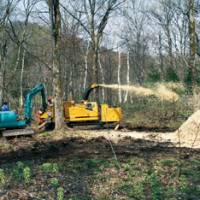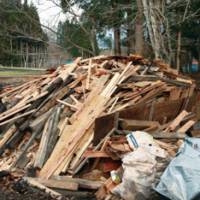The March 11 megaquake and tsunami, and the ongoing disaster at the Fukushima No. 1 nuclear power plant that they triggered, has sideswiped all of us. Nagging worries about the dangers of the radioctivity leaking from that crippled facility and concern for those brave souls striving to tackle the plant's many problems leave a dull, aching anguish that won't go away until we are all assured that it really is safe. Even then, doubts will linger.
But what is to be done with the mountains of debris now strewn along some 400 km of the northeast coast where cities and towns and villages once stood?
Nobody envies the work of those who are clearing it away — a dangerous, dirty task at best, made all the more onerous by the possibility of finding human remains. Our hearts go out to all those involved.
Looking at the thousands of images of those destroyed communities, it seems to me that more half the debris is comprised of wood. I ask myself and various other experts, can this wood be recycled? Do we want it to be recycled? Can the bulk of it be turned into chips by heavy chipping machines?
Huge tub-grinder machines can handle timber debris of any size, and the odd nail or screw wouldn't trouble them much. Such machines have carbide-tipped flail hammers that pulverize the wood rather than cut it — and they really gobble the stuff up. There are also many types of smaller wood chippers, easily moved by a tractor or four-wheel-drive mini-truck, that can handle logs up to 15 cm in diameter.
In our Afan Trust woods here in the Nagano Prefecture hills outside Kurohime, we hire a machine and operators from a local construction company to turn trimmed-out branches and poor-quality logs of up to 25 cm diameter into chips that we use for our pathways, where they eventually turn into compost. Such chips are easily handled and transported, and could probably be burned as fuel. However, I would be careful about using wood-chipped tsunami debris for compost or pathways because of the possibility of pollution from all the other stuff that was washed around and smashed in the disaster.
How to dispose of mountains of woody debris is just one of thousands of difficult choices that must be made, and made very quickly — as noted in a speech given in Tokyo on April 14 by Kenneth Neil Cuiker, Japan correspondent of he Economist, who said, "Japan has difficult choices it must make. It is vital that it constructs the future, not simply rebuilds the past."
He went on to say: "Some argue that the tsunami's ferocity shows that existing protections were inadequate. The mayor of Rikuzentakata — a small city in Iwate Prefecture that I visited a few days after the disaster, and which was utterly washed away — has suggested literally moving a mountain to raise the city's ground level higher. Here in Tokyo, Prime Minister Naoto Kan speaks of elevating entire communities."
Mr. Cuiker questioned the wisdom of this, and went on to say: "For instance, instead, perhaps establish better ways to respond to those rare tsunamis that only occur once in 1,000 years. The risk, otherwise, is that Japan goes bankrupt for the next 999 years trying to protect against them.
"Also, rather than reconstruct the same homes, factories and roads, this is a chance to build 'smart cities' which use energy more efficiently and provide easier access to public services."
Mr. Cuiker then made another sensitive but very crucial point, saying, "Many of the communities in the region were in decline prior to the disaster. Young people were moving away while the elderly remained. Before 3/11, a debate simmered over consolidating towns to operate more efficiently. Today, the real choice will be not how to rebuild — but whether to rebuild at all.
"The temptation to grant survivors their last wish and restore what was lost is enormous. But it should be resisted. I say it with the frankness of a friend, that Japan must rebuild the region for its children, not its great-grandparents."
I heartily agree. Indeed, I would go further, to say that Japan should endeavor to encourage more young families and vigorous retirees to resettle in rural areas all over Japan. There is plenty of land; there are lots of unused fields, rice paddies, woodlots and pastures; and there are even houses vacant in the countryside. The population of our own little Shinano town has dropped from more than 12,000 when I first came here in 1980 to just under 10,000 now. So if people are willing to share, we , too, have lots of space.
Japan needs to build a modern, vibrant and diversified forestry and agriculture sector, and to bring back each and every one of its mountain streams to sustainable life. This, of course, will require the old-style pork-barrel monster of politics and construction-industry concrete to be tamed — or, wherever possible, banished.
Less than a century ago, with its myriad streams, natural lakes and tameike ("warming ponds," into which icy mountain water was channeled to warm up before it was used to flood the rice paddies), Japan had one of the healthiest, most sustainable and diversified freshwater fisheries in the world.
This could be revived, enhancing not only domestic self-sufficiency in protein (there's indigenous salmon, char, trout, carp, lake smelt, eels and freshwater shrimps, as well as tasty alien species now here to stay, such as black bass, bluegill, catfish and crayfish), but also the lifestyles, leisure and scenery.
Streams that were unpolluted yet rich in oxygen and natural forest nutrients would do a great deal to heal the damage done to coastal fisheries by this latest disaster and other pollution as they mix with tidal waters and flow out to the sea.
On April 18, two young men, Ken Hachimaru and Takashi Iwama, came from Iwate Prefecture to visit our beautiful new Afan Woodland Trust Centre and see the woods for themselves.
Hachimaru and Iwama are among the last remaining Japanese horse-loggers. Their dream is to bring back the environmentally friendly skills of horse-logging to Japan and to tackle the great task of sensibly trimming out the ubiquitous plantations of Japanese cedars, cypress and larches, many of them privately owned, relatively small in area, and on steep slopes. The cost of using heavy extraction equipment and of building wide, bulldozed logging roads is both financially high and environmental unsound. Using horses to haul out the felled timber is a far better solution.
Horse-logging? Sounds old-fashioned? Although the skills almost died out in Britain in the 1980s, it is coming back with a vengeance — and in a greatly improved form from days gone by, with modern equipment that is far safer, more efficient and easier to use by even a simple one-man, one-horse team.
It has long been my ambition to bring these skills to our own Woodland Trust, and I was delighted to meet those young men, who are not only using horses in the woods in Iwate, but who are off to attend a course in horse-logging in Britain. They are fast becoming internationally aware, and they have a dream to recreate communities rooted in sustainable forestry and farming.
Meanwhile, now that the snow has mostly gone, I really must tackle the big pile of scrap wood left over from building our center. The good stuff we will recycle, while the rest will either be cut for kindling or turned into wood chips for our paths or to use as mulch around transplanted trees.
I can no longer look at a pile of woody debris, no matter how small or seemingly insignificant, without being reminded of the tragedy of the 3/11 tsunami. Those images are imprinted on my soul for life.




















With your current subscription plan you can comment on stories. However, before writing your first comment, please create a display name in the Profile section of your subscriber account page.